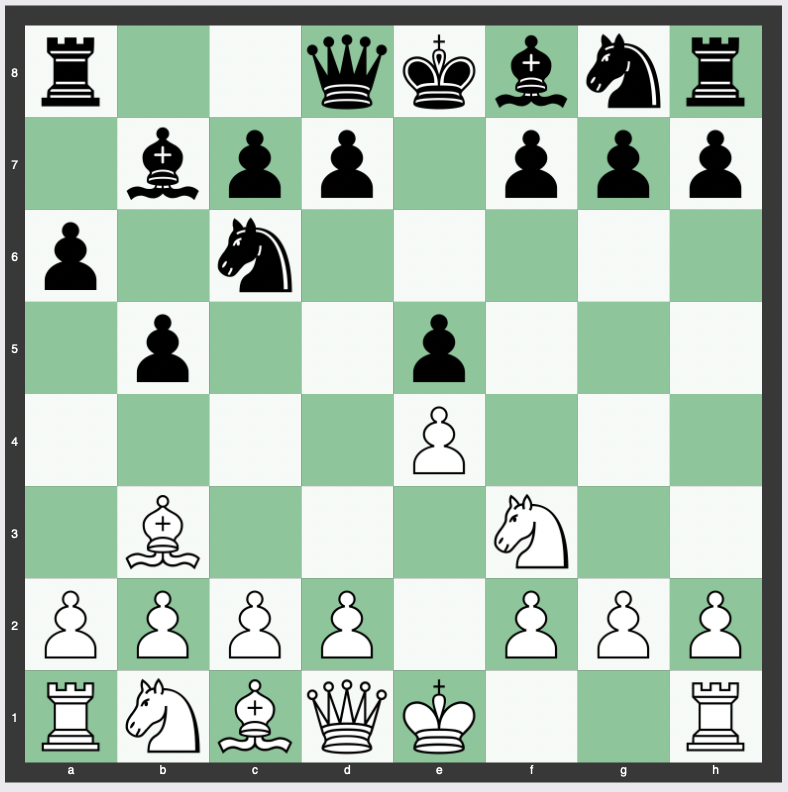The Caro Variation of the Ruy Lopez is an offshoot of the Spanish Game that offers a unique mix of defensive solidity and strategic complexity, catering to players of diverse styles and skills.
This article aims to delve deep into the Caro Variation, covering its move order, theory, strategy, variations, and history, and its suitability for beginners, intermediates, and even Grandmasters.
Move Order of the Caro Variation
The Caro Variation of the Ruy Lopez starts with the moves 1. e4 e5 2. Nf3 Nc6 3. Bb5 a6 4. Ba4 b5 5. Bb3 Bb7.

These moves form the core foundation of the Caro Variation.
- e4 and e5 set the board for open game play, allowing both white and black to control the center quickly.
- Nf3 and Nc6 follow suit, allowing the knights to be developed to their most optimal squares.
- Bb5, the signature move of the Ruy Lopez, pins the knight and exerts pressure on the e5 pawn.
- After a6 (Morphy Defense), white retreats the bishop to a4, preserving the bishop and keeping the pin intact.
- b5 and Bb7 see black expanding on the queenside and fianchettoing the bishop, aiming to counter white’s center and prepare for kingside castling.
Theory, Strategy and Purpose of the Caro Variation
The underlying strategy of the Caro Variation revolves around a robust defense and counterattacking prospects.
The early pawn moves a6 and b5 help black to gain space on the queenside, creating a stable position and denying white the opportunity for easy expansion.
The Bb7 move is an integral part of the Caro Variation, aiming to challenge white’s central e4 pawn and preparing to launch a counterattack.
Despite having a seemingly passive setup, black’s strategy is often to bide their time, slowly improve their pieces, and strike back at the right moment.
The purpose of the Caro Variation is to provide black with a solid, if somewhat passive, position from which they can safely navigate the middlegame and look forward to a favorable endgame.
Variations of the Caro Variation
Within the Caro Variation of the Ruy Lopez, there exist a few sub-variations that players can employ based on their strategic preferences.
In some lines, black might opt to delay the development of the Ng8, focusing instead on d7-d6 and Be7, leading to a more solid but less active setup.
Another notable sub-variation involves an early d7-d5 from black, challenging white’s center immediately. This approach can lead to a more dynamic position with chances for both sides.
These variations provide a range of strategic and tactical possibilities, demonstrating the flexibility of the Caro Variation within the Ruy Lopez.
History of the Caro Variation
The Caro Variation is named after Horatio Caro, a strong British player from the late 19th and early 20th centuries.
The variation was developed as a reliable alternative to the mainline Ruy Lopez, offering a unique balance of solid defense and counterattacking potential.
Despite not being as popular as some other Ruy Lopez variations, the Caro Variation has seen use in many high-level games throughout chess history.
Chess Opening: Ruy Lopez, Caro Variation
Is the Caro Variation Good for Beginners or Intermediates?
The Caro Variation can be a good choice for both beginners and intermediates due to its emphasis on solid defense and gradual improvement of the position.
For beginners, this variation teaches important concepts like pawn structure, piece development, and strategic planning.
The relatively less tactical nature of the Caro Variation allows beginners to focus more on understanding the strategic nuances of the game.
Intermediate players can also benefit from studying the Caro Variation.
As the position often remains balanced for an extended period, players can deepen their understanding of middlegame strategy, pawn dynamics, and endgame transitions.
How Often Is the Caro Variation Played at the Grandmaster Level?
At the Grandmaster level, the Caro Variation is not as frequently played as some of the mainline Ruy Lopez variations. However, it still sees occasional use.
The less tactical and more strategically complex nature of the Caro Variation means it often emerges in games where the player with the black pieces is content with a solid, less confrontational setup.
Despite its relative rarity, the Caro Variation remains a part of the repertoire of many top-level players, reflecting its enduring strategic appeal.
Conclusion
The Caro Variation of the Ruy Lopez, with its blend of defensive sturdiness and strategic depth, offers a fascinating divergence from mainstream chess openings.
It’s a variation that caters to beginners seeking to grasp fundamental chess principles and intermediates aiming to refine their strategic play.
Though less commonly seen at the Grandmaster level, the Caro Variation continues to contribute to the rich opening repertoire of chess, serving as a testament to the game’s variety and enduring appeal.


